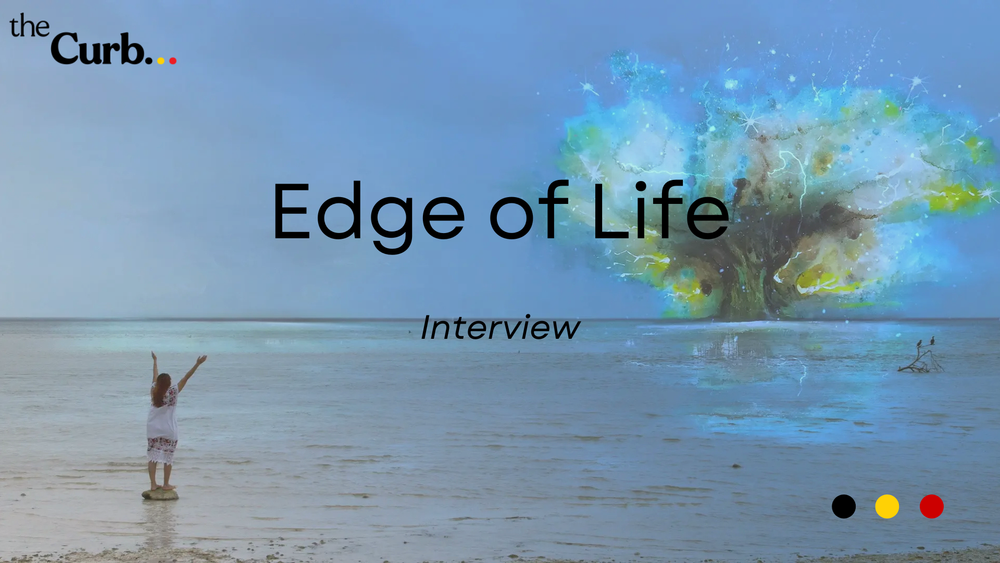Collaborative filmmaker and documentarian Lynette Wallworth expands her exploration of the death experience with her latest film Edge of Life. This expansive documentary bridges Western and Eastern medicine and traditional practices, and in the process, it introduces psilocybin's to the death process.
Subscribe to the Curb podcast via RSS feed, Apple Podcasts, Spotify, or iHeart Radio.
Download the episode directly here.
Lynette's relationship with death is influenced by her own experience of mortality; namely, the experience of having died and being revived when she was 11 years old. While that experience is not directly explored within Edge of Life, it is one that has informed her creative output, with her immersive virtual reality work Awavena exploring the role of cultural rejuvenation as experienced by Brazilian Amazonian tribes. On the stage, Lynette explored cults and creation within HOW TO LIVE (After You Die). Then there's the AACTA award winning Tender, a feature documentary which sees Lynette explore how the inhabitants of the industrial seaside town of Port Kembla look after their own dead.
I recall a period of time where sex, sexuality, and gender were the taboo subjects. This was in the nineties, and I remembered thinking 'well, if sex and sexuality are taboo, then what's more taboo than that?' When I started losing members of my own family, and then later, a close friend who was a school mate, I realised that the other taboo was death and dying. That taboo was permanently fractured when 9/11 occurred. This of course wasn't the first time that an immense loss of life was broadcast across the globe, but it was one of the first times that mass civilian loss was presented.
But Edge of Life isn't about exploring death in that manner, it's instead about fracturing Western cultures relationship with extended life preservation and allowing a transition towards embracing a grander quality of life mindset which will then underpin and inform how we can facilitate comfortable deaths for those entering palliative care. Lynette introduces us to Dr Marg Ross and Dr Justin Dwyer, two Naarm-Melbourne palliative care specialists who undertake a research process to see how psilocybin can help the transitional state from life to death for their patients. Some 35 participants engaged in their three-year trial of psychedelic-assisted therapy for terminally ill patients, and during the process, participants noted reductions in depression and anxiety as they underwent palliative care.
Edge of Life, then, is another step forward is dismantling Western taboos in relation to death and dying. To assist with this process of dismantling taboos, Lynette embeds the perspectives of Amazonian and Maya shamans who have used psychedelics like ayahuasca within their work for generations. We're introduced to Muka Yawanawa, a shaman of the Yawanawá people, and it's their presence in the film that embeds a transitory perspective of death and dying that underpins the lessons that Western culture can learn from the Yawanawá people. In stunning animated sequences, we're presented with visions of how the Yawanawá see the transition from living to a dying state and then death that informs the mindset that 'everything is alive.'
By opening up these conversations about death and dying, we're then able to strip away the dehumanising way of delivering information about our mortality. I've gone through my own experiences of death and mortality, and I've become rather glib about my own fluid state of existence to the point that it can offend some people. I'm aware of that, but the reality is that for people with chronic illness, disability, or in the case of the patients in Edge of Life, terminal illnesses, the possibility of death arriving next year, next month, next week, or tomorrow, is a very real one. Seeing how psilocybin has assisted those who are going through the palliative care process, and knowing how it has also assisted those with immense depression and anxiety, I can only imagine what possibilities it might offer me or my fellow chronically ill folks in the future.
In one of the later moments of Edge of Life, when Muka Yawanawa meets with Dr Justin Dwyer in a rather clinical office space, I was reminded of the other aspect of the bridging nature between Eastern and Western medicine that is almost a taboo in itself. Namely, that of the colonial aspect of taking or utilising another cultures way of life to enhance ours. Dr Dwyer shows Muka the Western version of psilocybin; it's a tablet, not a mushroom, and it appears rather sterile in form. The organic relationship between life, nature, and the passage that occurs when death becomes the state where they are merged together, feels absent when it sits in the form of a white pill. There's a clinical reason for it, of course, but it can't help but feel like the soul of the machination of utilising psychedelics to assist with the dying process has dissipated here, and in the process, the connection to the Yawanawá way of life feels lost.
But, as Muka mentions, this is about the process of transitioning to our next state of being, whatever that may be. To quote, 'this connection was like bringing light into shadow.' Lynette embeds that Yawanawá presence through the visuals of Edge of Life, an aspect that helps amplify the co-authored nature of the film, with fellow Awavena producer Tashka Yawanawa credited as co-writer of the piece.
Like a lot of Lynette's body of work, Edge of Life feels as if it is another piece in a grander thesis about the documentarians own life-to-death process. It's hard to know how that story will end, and it's impossible to know what Lynette will experience when that time comes for her and she does step into her next state, but in the meantime, it's fascinating to see how she has continued to use the function and form of cinema and art - through VR, XR, stage, and documentary storytelling processes - to explore and dismantle the taboo subject of death and dying.
I'll close this introduction off with a frank note. There have been, and will continue to be, many documentaries about the clinical research processes that are undertaken in the exploration into better ways of practice to treat those who are in palliative care. I'm grateful that these stories are being told and that the societal mindset - at least from an Australian perspective - is shifting in relation to psychedelics and how they can assist with our growing mental ailments. We are learning more and more about the mind, how it fractures, and how it attempts to heal itself after trauma, and psychedelics are just one aspect that can help that healing process.
However, there does, at times, feel like we are in a stasis point where films and news articles about these research processes are made, publicised, and shared, influencing audiences and readers alike, yet the avenues remain closed to access them. The sooner that these options are more widely available and accessible to people undergoing these processes, the better. I know that when my physical state reaches that point of exhaustion and fracture, that I will want to have access to these treatments.
These subjects, and more, are discussed in this interview with Lynette Wallworth, recorded during the national release of Edge of Life, currently in a limited run in Australian cinemas. Check out your local cinema guide for details, or visit Kismet Movies for additional information on where and how to view the film. To find out more about Lynette's work, including listening to her lectures, visit LynetteWallworth.com.
the Curb is a reader and listener supported independent publication. To help keep us independent, visit our Subscription page for membership options.
Screening or Streaming Availability from JustWatch:

